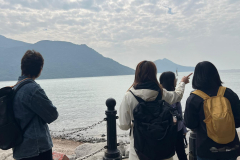
- Date: Oct 30 – Dec 24, 2024
- Venue: Ping Yuan and Kinmay W Tang Gallery, Library
- Opening Hours:
- Monday – Friday, 9 am – 6 pm
- Saturday & Sunday, 11 am – 6 pm
- Special Opening Hours:
- Dec 21, 2024 (Sat): 11 am – 4 pm
- Dec 22, 2024 (Sun): 1 pm – 6 pm
- Dec 23, 2024 (Mon): 9 am – 6 pm
- Dec 24, 2024 (Tue): 9 am – 12:30 pm
- Enquiry: library@ust.hk
Introduction
This exhibition is organized and funded by the Division of Emerging Interdisciplinary Areas (EMIA) and the Division of Arts and Machine Creativity (AMC) at HKUST, as well as the Computational Media and Arts (CMA) at HKUST (GZ). It offers new insights into the relationship between biology and computational art.
The participants are primarily PhD students and researchers from HKUST, HKUST (GZ), and Monash University, with academic support from Prof. Huamin Qu, Prof. Kang Zhang, and Prof. Jon McCormack. This exhibition is initiated by Ziwei Wu and Danlu Fei, with curator You Wang and designer Hanlu Ma, and features works by artists Ziwei Wu, Danlu Fei, Xinyu Ma, Xiaofu Jin, Yifang Wang, Burak Korkmaz, Wen You, Hanlu Ma, Mengying Du, Meng Yang, Jiagi Shi, Hengyu Meng, and Wanchao Su.
This exhibition features 10 artworks that combine cutting-edge approaches such as AI-generated content and data visualization with traditional artificial life (ALife) methods, including genetic algorithms and agent-based systems. Through diverse themes such as climate change, ecological crises, toxic food, and the possibilities of transformation and becoming “the other,” the artists explore and represent the concept of “Altering Nature.”
Foreword
What is life, and what does it mean to be intelligent? How can we empathetically perceive the perspectives of both human and non-human living beings? How do creators understand nature and utilize different media to alter artificial life forms? The exhibition “Altering Nature” invites visitors to explore and discuss the potential forms of coexistence between organic and artificial life.
In the late 1980s, Artificial Life (ALife) emerged within a cultural context where artists and theorists were exploring the implications of life, alongside the rise of computing, robotics, and synthetic biology. ALife investigates “life-as-we-know-it” as well as “life-as-it-might-be”. Software ALife studies natural life by recreating biological phenomena within computers and other artificial media, using a generative approach that assembles systems mimicking living beings.
Meanwhile, in an era where AI is fueled by data, the exhibition highlights how the quality, origin, and curation of data shape behaviors and foster a new understanding of nature. Life-like visuals and creatures can also be generated from data inputs with algorithms. Life in the digital age is increasingly defined and reshaped by data, drawing attention to the evolving relationship between technology and biology. For example, traditional ALife technologies, such as genetic algorithms and agent-based systems, alongside new technologies like AI-generated content and data visualization, allow artists to explore and represent “Altering Nature” through themes such as climate change, ecological crisis, toxic food, and new possibilities of becoming others.
As technologies grow in complexity, the changes in nature become more diverse and intricate. Understanding the “Altering Nature” is important. This art tech exhibition provides a new lens through which to consider the evolving relationship between technology and biological understanding through computational art.



